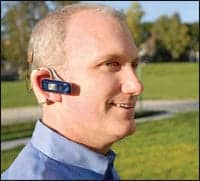We live in a world powered by sound-driven technology: navigation and GPS systems, iPods and MP3 players, cellular phones and PDAs. Increasingly, our daily routines are defined by touch screens and microchips’ ability to help us navigate our surroundings, get us to where we need to be, and keep us connected. This continuous evolution of digital and progressively wireless technology is embraced by much of today’s global population. However, for those with hearing loss, it is often met with the question, “Will it work for me?”
More than ever, people seek out my expertise as an audiologist and I am asked this question with specific relation to Bluetooth® technology. It is one that I answer with a smile and a resounding “Absolutely.”
Making the Connection
What is Bluetooth? An audio and data transmission system, Bluetooth enables wireless networking and connectivity among different devices, including personal media devices, computers, and cellular phones. More simply, it is a way for electrical components to communicate wirelessly. Perhaps the most recognizable form of this technology is the Bluetooth headsets that sit on the ears of many and provide hands-free connections to cellular phones. Just look around you in the airport or the supermarket and, inevitably, you will see individuals with the telltale blinking blue light emanating from their ears.

|
| FIGURE 1. The T-Mic is an in-the-ear microphone designed for hearing in noisy environments and for effortless access to cellular telephones, consumer audio electronics, and assistive listening technology. |
More than 1 billion cellular phones were sold in 2007, according to Gartner Inc, nearly all of them “Bluetooth-enabled.” And with several states—including California, Connecticut, New Jersey, New York, and Washington—adopting hands-free driving laws, the demand for, and popularity of, Bluetooth technology is rising rapidly—even among those with hearing loss.
I learned this past summer while presenting at several national consumer events for people with hearing loss that many attendees were not aware that hands-free, wireless Bluetooth connections are available to them and that the devices are simple to use and easily accessible. Importantly, there are several accessory devices that are Bluetooth-compatible for connecting hearing aids and Bionic Ears (cochlear implants) hands-free to cellular phones, including the following:
- T-coil compatible neckloop receivers. A personal listening accessory worn around the neck and connected to a sound source. There are two styles of neckloop receivers—one that has a cord that plugs into the device the user desires to listen to (ie, wired) or there is a neckloop that also houses a Bluetooth transceiver to enable a wireless connection. The neckloop then converts the input sound signal to electromagnetic waves that radiate from the wire loop placed around the individual’s neck and are picked up by the telecoil in the hearing aid or cochlear implant processor.
- T-coil compatible induction earhooks. As an alternative to using conventional neckloops to pick up the electromagnetic signal, there are now very small and lightweight earhooks that can be worn on the ear, right next to the hearing aid or cochlear implant. As with the neckloop, an individual has the choice of the wired option that plugs into the device or the wireless Bluetooth option.
- T-Mic®. A microphone at the tip of the unique BTE earhook that offers the opportunity to “cut the cord” for a wireless connection.
Can You Hear Me Now?
The T-Mic was initially designed as an earhook accessory option to help Bionic Ear users connect to their cellular phones and headphones, and its natural placement of the microphone enables users to receive sound at the same place that those with normal hearing do—at the level of the opening of the ear canal. By taking advantage of the natural placement, this device also allows users to wear and use wireless Bluetooth headsets in the same way normal-hearing people do.
Additionally, it is not necessary to special order Bluetooth accessories or wait until a tradeshow to buy a specialized product for use with the T-Mic; an individual can use most of the off-the-shelf products available. However, it is recommended that a style is chosen based on the following:
- Comfortable fit on the ear, as some of the earpieces are thicker than others.
- A flat speaker as opposed to one that extends into the ear canal. An example of this is the Motorola H700.
There is also the option of using the wireless Bluetooth headphones that serve dual purposes. The headphones allow users to listen to their iPod or MP3 player, and then when their cell phone rings, they can be connected to the caller via a built-in microphone simply by pressing the designated button on the headphones.
Ensuring a Clear Connection
Equally important to the Bluetooth hands-free device is the cellular phone it is connected to. While the Federal Communications Commission (FCC) mandates that cellular phone manufacturers and service providers make high-quality phones that produce less static, less interference, and better telecoil connections, especially for those using hearing aids and cochlear implants, it is still recommended that the cellular phones’ microphone/telecoil ratings be reviewed to ensure that the cellular phone is a fit for the user’s needs and is hearing aid compatible (HAC).
To determine if a phone is HAC, look for the label on either the cellular phone, the phone’s packaging, or the card next to the display phone. Review the microphone rating (M rating) and the telecoil rating (T rating). Ranging from 1 to 4, the higher the rating, the clearer the conversation will be for both the user as well as the individual on the other end of the phone. It is usually recommended that those with hearing loss seek out cell phones with at least an M3/M4 and/or T3/T4 rating.
Sometimes hearing aid or cochlear implant users experience interference when using digital cellular phones, which transmit information on radio frequency (RF) that is picked up by the electronic circuitry or telecoil housed in their amplification. This can create an audible interference or buzz. The interfering energy may come from many parts of the cellular phone, including the backlight, antenna, battery, and internal circuitry. To minimize or completely avoid the buzzing, keep the following tips in mind:
- Connection device: Use a T-Mic, as opposed to a telecoil, which usually minimizes interference, since the cellular phone can be worn at a distance from the processor.
- Design of phone: Clamshell or flip-style phones, as opposed to open-face phones, tend to put the bulk of the receiver below the ear and position the extended antenna away from the head. This reduces the interference by increasing the distance of the phone and antenna from the processor.
- Wireless service: Cellular phone companies use different transmitting technologies for their wireless services; some cause more problems than others. When seeking a wireless provider, make sure to look for the following items:
- Providers that use the CDMA digital protocol, such as Verizon or Sprint, or iDEN technology, such as Nextel, tend to cause the least interference.
- Find the CDMA or iDEN provider that has the best network coverage in the area(s) where the phone will be used (eg, home, office, other cities and places where you travel).
- GSM and TDMA protocols are prone to cause interference with cochlear implants.
- Ask a cellular phone provider to see models with reduced RF. Since 2005, the FCC requires most service providers and phone manufacturers to offer a certain percentage of cellular phone models with reduced emissions.
With any purchase, remember to talk to other users, even the audiologist, for their recommendations. And always try before buying. Contact the local cellular phone vendor and ask about using demonstration models in the store or in-home trials, as it is best to listen with several phones from several companies before making a decision.
Technology continues to enable individuals to do remarkable things. I’m reminded of this every day as I offer professional advice as an audiologist and walk in their shoes when I turn on my own Bionic Ears to communicate with my friends and family via cellular phone.As technological advances continue to unfold in the future, I am excited to see what lies ahead for those of us with cochlear implants.
Citation for this article:
Childress T. Breaking the silence with Bluetooth technology. The Hearing Review. 2008;15(12):28-30.





